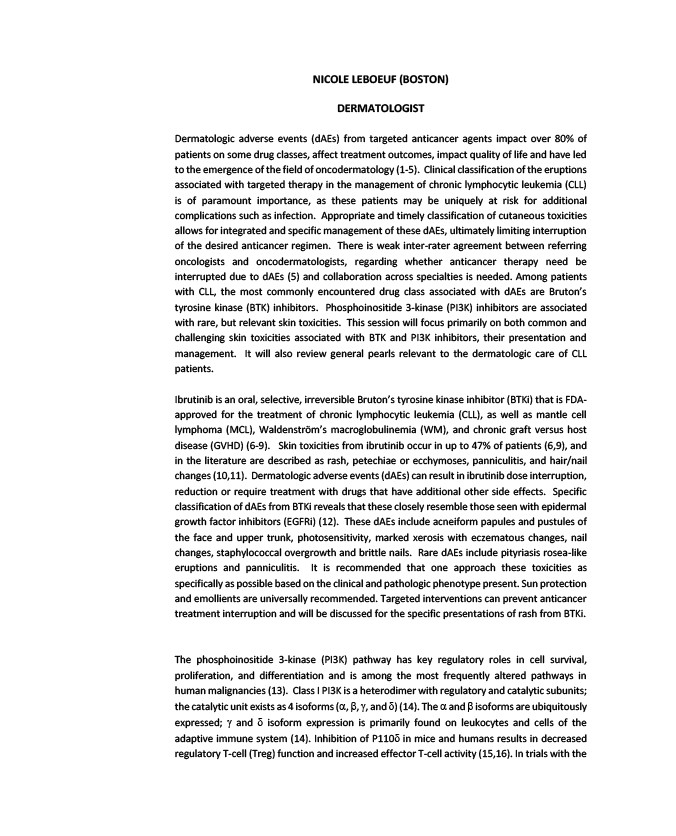
NICOLE LEBOEUF (BOSTON)
DERMATOLOGIST
Dermatologic adverse events (dAEs) from targeted anticancer agents impact over 80% of
patients on some drug classes, affect treatment outcomes, impact quality of life and have led
to the emergence of the field of oncodermatology (1-5). Clinical classification of the eruptions
associated with targeted therapy in the management of chronic lymphocytic leukemia (CLL)
is of paramount importance, as these patients may be uniquely at risk for additional
complications such as infection. Appropriate and timely classification of cutaneous toxicities
allows for integrated and specific management of these dAEs, ultimately limiting interruption
of the desired anticancer regimen. There is weak inter-rater agreement between referring
oncologists and oncodermatologists, regarding whether anticancer therapy need be
interrupted due to dAEs (5) and collaboration across specialties is needed. Among patients
with CLL, the most commonly encountered drug class associated with dAEs are Bruton’s
tyrosine kinase (BTK) inhibitors. Phosphoinositide 3-kinase (PI3K) inhibitors are associated
with rare, but relevant skin toxicities. This session will focus primarily on both common and
challenging skin toxicities associated with BTK and PI3K inhibitors, their presentation and
management. It will also review general pearls relevant to the dermatologic care of CLL
patients.
Ibrutinib is an oral, selective, irreversible Bruton’s tyrosine kinase inhibitor (BTKi) that is FDA-approved
for the treatment of chronic lymphocytic leukemia (CLL), as well as mantle cell
lymphoma (MCL), Waldenström’s macroglobulinemia (WM), and chronic graft versus host
disease (GVHD) (6-9). Skin toxicities from ibrutinib occur in up to 47% of patients (6,9), and
in the literature are described as rash, petechiae or ecchymoses, panniculitis, and hair/nail
changes (10,11). Dermatologic adverse events (dAEs) can result in ibrutinib dose interruption,
reduction or require treatment with drugs that have additional other side effects. Specific
classification of dAEs from BTKi reveals that these closely resemble those seen with epidermal
growth factor inhibitors (EGFRi) (12). These dAEs include acneiform papules and pustules of
the face and upper trunk, photosensitivity, marked xerosis with eczematous changes, nail
changes, staphylococcal overgrowth and brittle nails. Rare dAEs include pityriasis rosea-like
eruptions and panniculitis. It is recommended that one approach these toxicities as
specifically as possible based on the clinical and pathologic phenotype present. Sun protection
and emollients are universally recommended. Targeted interventions can prevent anticancer
treatment interruption and will be discussed for the specific presentations of rash from BTKi.
The phosphoinositide 3-kinase (PI3K) pathway has key regulatory roles in cell survival,
proliferation, and differentiation and is among the most frequently altered pathways in
human malignancies (13). Class I PI3K is a heterodimer with regulatory and catalytic subunits;
the catalytic unit exists as 4 isoforms (a, b, g, and d) (14). The a and b isoforms are ubiquitously
expressed; g and d isoform expression is primarily found on leukocytes and cells of the
adaptive immune system (14). Inhibition of P110d in mice and humans results in decreased
regulatory T-cell (Treg) function and increased effector T-cell activity (15,16). In trials with the